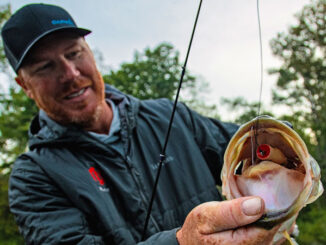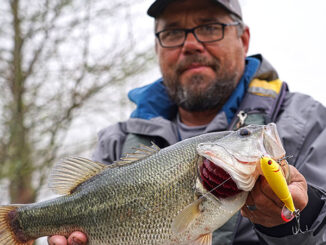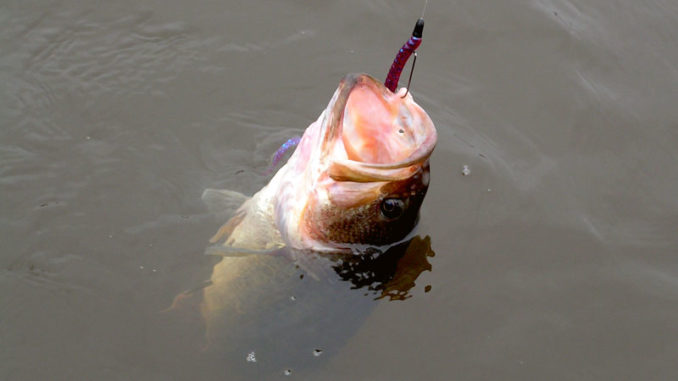
I’ll never forget the cast that turned on the light for me.
I was fishing with my father-in-law, Jack Brumfield, on Toledo Bend, when it happened.
We were fishing down a shoreline that had a little bit of everything: brush tops, boat docks, fallen trees, grass lines, the works. And we were catching a few bass. As we rounded a small point, I noticed a single, small stickup poking out of the water about 3 inches, with nothing else around it. It was just out of casting range, so I moved closer and cast my purple lizard next to it. Before the bait hit bottom, the line immediately headed right back to the boat. I reeled up the slack and set the hook. A few minutes later, a huge bass was jumping by the boat trying to escape the landing net.
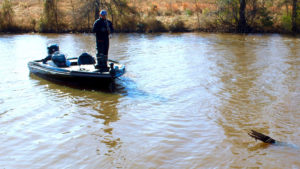
The bass showed 81/4 pounds on the little Zebco scale; this was a while back, before digital scales were popular. The big fish went back in the water, but the lesson learned stayed in the boat. Over the years, the pattern has paid off more times than I can remember.
Never underestimate what a big, old bass may be laying up beside, especially this time of year. A little stickup, a lone pole from an abandoned pier, a single lily pad or strand of grass could be holding a springtime lunker. Big females tend to want to hold in a spot away from the bass crowd when they are approaching the time to spawn, and they look for the same type cover when they are finished.
Greg Terzia, a bass pro who owns Terzia’s Bait and Tackle in Ruston and is director of North Louisiana Media Bass tournaments, has noticed the same thing.
“If you find an isolated stickup or small tree, especially in the early spring in shallow water, there’s a good chance there’s a bass by it, and there’s a really good chance it’s a good one,” he said. “Sometimes, I’ll troll or idle 5 minutes all the way across a flat just to fish a stickup, single tree or old duck blind post that’s all by itself. There’s a good bet it’s got a good fish on it.”
Terzia said it pays to keep your eye out for those kind of spots, and not only because they produce bass, but they often reload with another good bass fairly quickly, sometimes within just an hour or so. So always check them more than once.
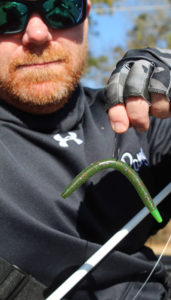
Sometimes, these little isolated stickups look so good it makes Terzia nervous.
“I’m not kidding; when you see a little spot like that, you get more worked up than a regular cast because you know you’ve got to put the bait right in the best spot. I won’t throw a crankbait or spinnerbait,” he said. “I’ll fish something subtle, like a Rattlin’ Rogue. I’ll toss it out past the stickup, ease it right by the structure and then let it sit there. They’ll just rise up and suck it in. But if you make a bad cast and get hung up or spook the fish, it’s game over.”
Big fish will sometimes roll and miss the Rogue, but Terzia sends a 5-inch Senko back in the spot before the ripples are gone, and nine times out of 10, the bass will gulp that down. If they don’t hit that, his secret “third-time-is-the-charm” try is usually with a shaky head with a Zoom finesse worm on 8-pound line. If they are there and you drop it in their face, they can’t resist, he said
“Big bass are territorial, and they find spots like that to call their own,” Terzia said. “If they are females and have spawned, or are getting ready to, they’ll find a spot like that. They aren’t hanging out there necessarily to feed, but if they’ve been sitting there all day and something drops by, they’ll nail it. Well, they’ll eat it. It may be a more subtle bite than you’d expect. Pay close attention, and watch your line, too.”
Terzia is an old-school bass angler, and this kind of fishing is his happy place. He said electronics gets so much attention these days, that it’s good to have a way and a place to fish where the anglers’ skills at finding and catching fish come into play without staring at a fish on the screen in front of them before they catch it.
“I’ve got nothing against the guys that do that, but man, to me, it just isn’t any fun,” he said. “The game has changed, but I think I’ll just stick with the old ways, especially in the spring.”
Well played.
Any good lesson is worth repeating. So, here it is in a nutshell:
You don’t have to find mega brush piles or piles of sunken logs that look like a pulpwood truck that’s turned over to find spring bass. Often, some of the biggest bass will hang by the smallest pieces of structure. It can be one little stickup, a single strand of grass or a small change in the depth. Talk to fishermen and find out how they look for single pieces of structure and target them for post-spawn bass in the Bayou State. These spots are worthy of more than one cast with more than one bait.
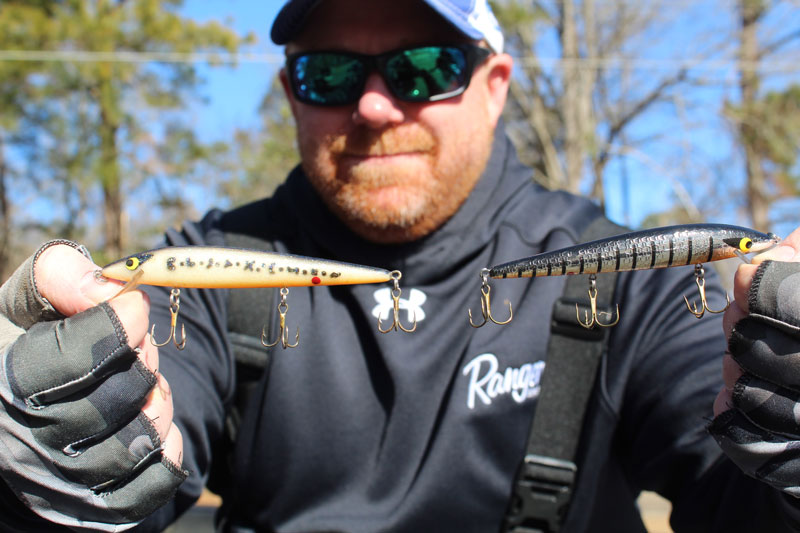
It makes sense: stickbaits for stick bass
When it comes to choosing lures, you can’t beat the combination of owning a tackle store and fishing bass tournaments. That’s why you should pay attention to the stickbaits that Greg Terzia picks for “stick bass.”
Stickbaits are simple baits. They don’t dive, wobble or have propellers. They are like sticks. Most of them float on the surface, and when you reel them in, they just come in. There are also stickbaits that sink slowly and even plastic stick baits that sink slowly enough to cover every inch of a stickup in shallow water. Some fishermen jerk or twitch the bait, but this time of year, just letting it sit in front of a big bass is probably the top technique.
Some of Terzia’s favorites are Smithwick Rogues in chrome with a black back and orange belly and Yellow Magics that you can put right in front of the fish and let them sit.
Hard-plastic stickbaits work, but sometimes you need a lure that will sink down on the fish. That’s when Senkos are productive. Two new colors, African and tilapia magic, have quickly become Terzia’s favorites. A new bait, Zoom’s Fluke Stick, looks like a Senko with a Fluke tail on one end. Watermelon and watermelon red are his favorite colors, mainly because that’s what the fish seem to favor.
A little spring secret? Terzia likes to dip the tails of his stickworms in a little Spike-It Dip-N-Glo dye to kick it up a notch.
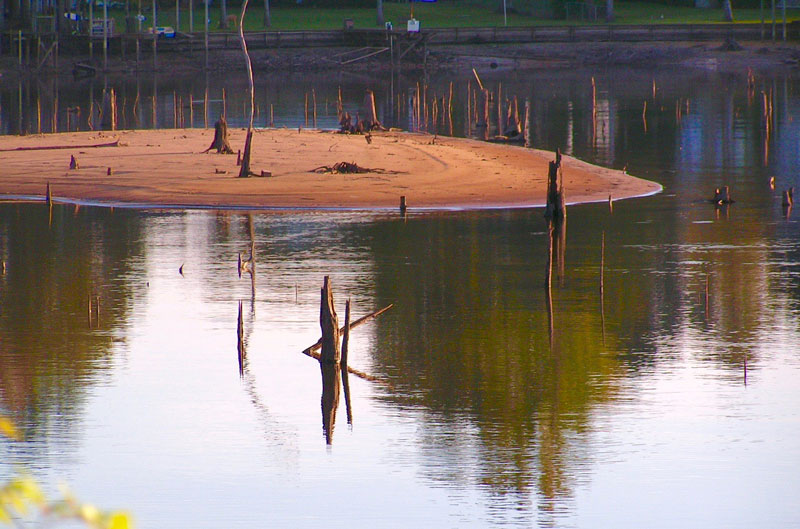
Anatomy of a stick: There’s often more than meets the eye
The bottom line on why many fishermen pass up casting to a single stick poking out of the water is, frankly, it just doesn’t look like much — but there’s often more than meets the eye.
It’s true; sometimes a single stickup has some magic quality that just attracts bass. Anglers find that those places tend to hold fish all the time. Even if you catch one there, another will move in. It’s hard to explain.
But often, the stick has help. It could be on a subtle hump, or the stick might belong to a big stump or log. It could be the only visible limb on a big, fallen tree.
When a lake is drawn down, you can sometimes see why your favorite stickup holds fish. It might be on the top of a shallow hump that is normally in 4 feet of water when the surrounding water is 10 feet deep. That’s the kind of natural spot that attracts baitfish and bass.
In a world where more and more anglers rely on looking at a sonar screen to find fish and fishing spots, it’s nice to know there are some places you can still catch fish just by doing this simple thing: fishing for them.

